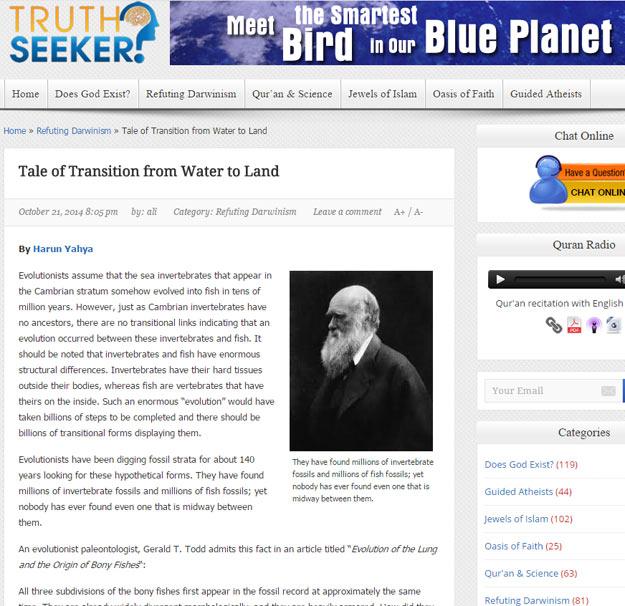
Evolutionists assume that the sea invertebrates that appear in the Cambrian stratum somehow evolved into fish in tens of million years. However, just as Cambrian invertebrates have no ancestors, there are no transitional links indicating that an evolution occurred between these invertebrates and fish. It should be noted that invertebrates and fish have enormous structural differences. Invertebrates have their hard tissues outside their bodies, whereas fish are vertebrates that have theirs on the inside. Such an enormous “evolution” would have taken billions of steps to be completed and there should be billions of transitional forms displaying them.
Evolutionists have been digging fossil strata for about 140 years looking for these hypothetical forms. They have found millions of invertebrate fossils and millions of fish fossils; yet nobody has ever found even one that is midway between them.
An evolutionist paleontologist, Gerald T. Todd admits this fact in an article titled “Evolution of the Lung and the Origin of Bony Fishes“:
All three subdivisions of the bony fishes first appear in the fossil record at approximately the same time. They are already widely divergent morphologically, and they are heavily armored. How did they originate? What allowed them to diverge so widely? How did they all come to have heavy armor? And why is there no trace of earlier, intermediate forms?
The evolutionary scenario goes one step further and argues that fish, who evolved from invertebrates then transformed into amphibians. But this scenario also lacks evidence. There is not even a single fossil verifying that a half-fish/half-amphibian creature has ever existed. This fact is confirmed by a well-known evolutionist authority, Robert L. Carroll, who is the author of Vertebrate Paleontology and Evolution, though reluctantly as: “We have no intermediate fossils between rhipidistian fish (his favorite ‘ancestors’ of tetrapods) and early amphibians.” Two evolutionist paleontologists, Colbert and Morales, comment on the three basic classes of amphibians-frogs, salamanders, and caecilians:
There is no evidence of any Paleozoic amphibians combining the characteristics that would be expected in a single common ancestor. The oldest known frogs, salamanders, and caecilians are very similar to their living descendants.
Until about fifty years ago, evolutionists thought that such a creature indeed existed. This fish, called a Coelacanth, which was estimated to be 410 million years of age, was put forward as a transitional form with a primitive lung, a developed brain, a digestive and a circulatory system ready to function on land, and even a primitive walking mechanism. These anatomical interpretations were accepted as undisputed truth among scientific circles until the end of the 1930’s. The Coelacanth was presented as a genuine transitional form that proved the evolutionary transition from water to land.
However on December 22, 1938, a very interesting discovery was made in the Indian Ocean. A living member of the Coelacanth family, previously presented as a transitional form that had become extinct seventy million years ago, was caught! The discovery of a “living” prototype of Coelacanth undoubtedly gave evolutionists a severe shock. The evolutionist paleontologist J.L.B. Smith said that he could not have been more surprised if he had come across a living dinosaur. In the years to come, 200 Coelacanths were caught many times in different parts of the world.
Living coelacanths revealed how far the evolutionists could go in making up their imaginary scenarios. In contrary to claims, coelacanths had neither a primitive lung nor a large brain. The organ that evolutionist researchers proposed as a primitive lung turned out to be nothing but a lipid pouch. Furthermore, the Coelacanth, which was introduced as “a reptile candidate getting prepared to pass from sea to land”, was in reality a fish that lived in the depths of the oceans and never approached to within less than 180 meters of the surface.
Turtles Were Always Turtles
Just as the evolutionary theory cannot explain basic groups of living things such as fish and reptiles, neither can it explain the origin of the species within these groups. For example, turtles, which are a reptilian species, appear in the fossil record all of a sudden with their unique shells. To quote from an evolutionary source: “… by the middle of the Triassic Period (about 175,000,000 years ago) its (turtle’s) members were already numerous and in possession of the basic turtle characteristics. The links between turtles and cotylosaurs from which turtles probably sprang are almost entirely lacking” (Encyclopaedia Brittanica, 1971, v.22, p.418)
There is no difference between the fossils of ancient turtles and the living members of this species today. Simply put, turtles have not “evolved”; they have always been turtles since they were created that way.
Adnan Oktar's piece on Truth Seeker:
http://www.truth-seeker.info/refuting-darwinism/tale-of-transition-from-water-to-land/


